Luc Vandendorpe
Aliasing in Near-Field Array Ambiguity Functions: a Spatial Frequency-Domain Framework
Dec 13, 2025Abstract:Next-generation communication and localization systems increasingly rely on extremely large-scale arrays (XL-arrays), which promise unprecedented spatial resolution and new functionalities. These gains arise from their inherent operation in the near field (NF) regime, where the spherical nature of the wavefront can no longer be ignored; consequently, characterizing the ambiguity function -- which amounts to the matched beam pattern -- is considerably more challenging. Implementing very wide apertures with half-wavelength element spacing is costly and complex. This motivates thinning the array (removing elements), which introduces intricate aliasing structures, i.e., grating lobes. Whereas prior work has addressed this challenge using approximations tailored to specific array geometries, this paper develops a general framework that reveals the fundamental origins and geometric behavior of grating lobes in near-field ambiguity functions. Using a local spatial-frequency analysis of steering signals, we derive a systematic methodology to model NF grating lobes as aliasing artifacts, quantifying their structure on the AF, and providing design guidelines for XL-arrays that operate within aliasing-safe regions. We further connect our framework to established far-field principles. Finally, we demonstrate the practical value of the approach by deriving closed-form expressions for aliasing-free regions in canonical uniform linear arrays and uniform circular arrays.
Point Target Near-Field Bistatic Imaging: Chirp-Based Aliasing Analysis
Dec 12, 2025Abstract:This paper presents a chirp-based framework for characterising aliasing in a bistatic Near-Field (NF) imaging system equipped with multidimensional antenna arrays. Extending monostatic formulations, we derive closed-form expressions for the maximum spatial frequency, enabling the analytical derivations of the conditions for aliasing-free image reconstruction. The framework also provides a geometric interpretation of aliasing based on the antenna array geometry, target position, and antenna element spacing. Numerical results corroborate theoretical findings and show that the aliasing-free region enlarges with smaller antenna spacing, greater target range, lower array dimensionality, and smaller arrays. These results enable more effective design of bistatic NF imaging systems.
Chirp-Based Aliasing Analysis of Arrays in the Spherical Wavefront Regime
May 08, 2025Abstract:In antenna arrays, wave propagation modeling based on Euclidean principles is typically represented by steering vectors or signals. This paper provides a new, chirp-based, interpretation of steering vectors in the Spherical Wavefront Regime (SWR), establishing a relationship between the spatial spectrum of the received (resp. transmitted) signal and the geometry of the array and the source (resp. target). Leveraging the well-known sampling theorem, we analyze aliasing effects arising from spatial sampling with a finite number of antennas and understand how these effects degrade the Ambiguity Function (AF). Our framework provides geometric insight into these degradations, offering a deeper understanding of the non-space-invariant aliasing mechanisms in the SWR. The proposed approach is formulated for general antenna arrays and then instantiated to Circular Array and to Uniform Linear Array structures operating in Near Field conditions.
Electromagnetic Modelling of Extended Targets in a Distributed Antenna System
Apr 30, 2025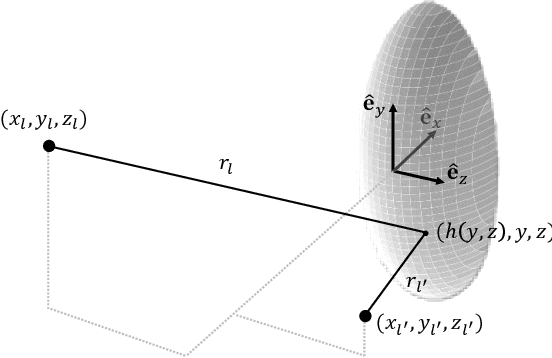
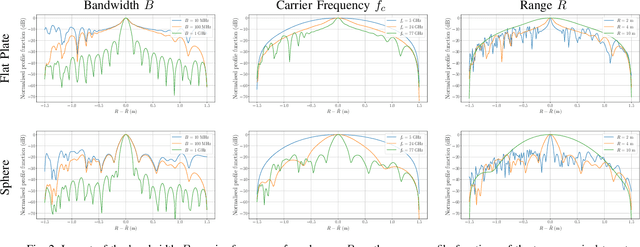
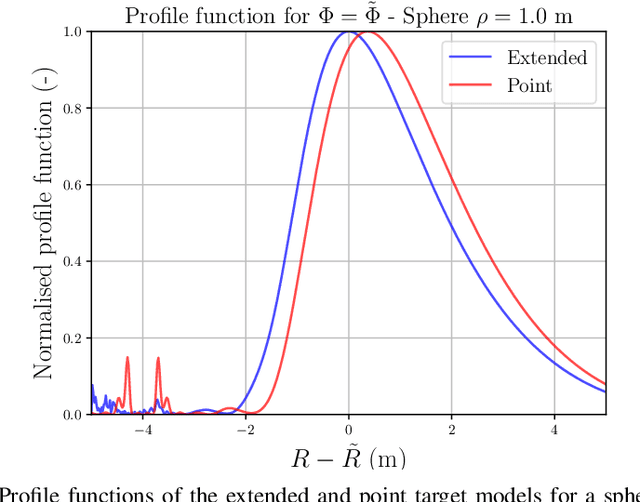
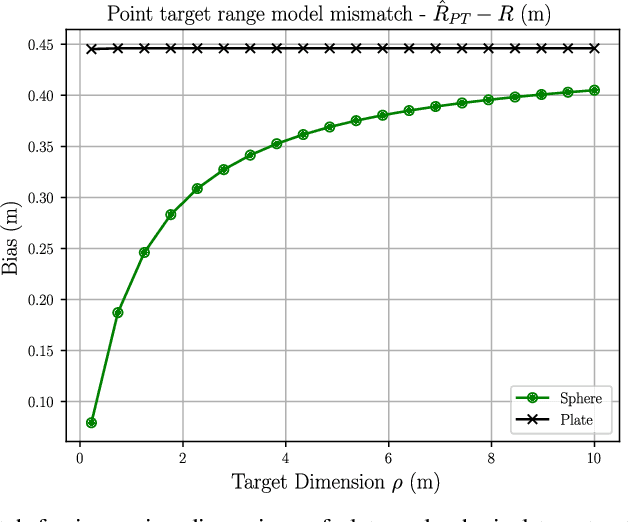
Abstract:Traditional radar and integrated sensing and communication (ISAC) systems often approximate targets as point sources, a simplification that fails to capture the essential scattering characteristics for many applications. This paper presents a novel electromagnetic (EM)-based framework to accurately model the near-field (NF) scattering response of extended targets, which is then applied to three canonical shapes : a flat rectangular plate, a sphere and a cylinder. Mathematical expressions for the received signal are provided in each case. Based on this model, the influence of bandwidth, carrier frequency and target distance on localisation accuracy is analysed, showing how higher bandwidths and carrier frequencies improve resolution. Additionally, the impact of target curvature on localisation performance is studied. Results indicate that detection performance is slightly enhanced when considering curved objects. A comparative analysis between the extended and point target models shows significant similarities when targets are small and curved. However, as the target size increases or becomes flatter, the point target model introduces estimation errors owing to model mismatch. The impact of this model mismatch as a function of system parameters is analysed, and the operational zones where the point abstraction remains valid and where it breaks down are identified. These findings provide theoretical support for experimental results based on point-target models in previous studies.
Interference Cancellation Schemes for Full-Duplex Integrated Sensing and Communication
Oct 01, 2024



Abstract:In this paper, the introduction of interference cancellation in full-duplex joint radar and communication receivers is analysed. More specifically, a focus is made on scenarios in which the receiver simultaneously receives radar echoes from the environment, and communication signals from other joint radar and communication transceivers. First, the phase-coded frequency modulated continuous wave waveform designed for integrated sensing and communication is presented. Then, simple structures in which interference cancellation is only applied at the radar or communication function are proposed, relying on the information gathered at the other function. The detection probability and bit error rate improvements are analysed numerically w.r.t. different system parameters, such as the communication constellation, or the number of transmitted pulses. The introduction of error correcting codes is also considered. Next, iterative interference cancellation structures are investigated. Thanks to multiple interference cancellation layers, both the radar and communication performance are improved, and the robustness of the system to any scenario is enhanced. This is shown numerically through the analysis of the performance achieved by simple and iterative structures, which are compared for different radar echo to communication signal power ratio. Finally, a dynamic automotive scenario is considered. Leveraging on previous radar measurements, the parameters of the radar echo are inferred, and it is reconstructed beforehand, enabling to remove the first radar processing block. The complexity of the iterative structures is thus reduced, at the price of a slight performance reduction. A dynamic automotive scenario is considered, highlighting the impact of the tracking of the next vehicle ahead on the system.
Positioning and transmission in cell-free networks: ambiguity function, and MRC/MRT array gains
Sep 12, 2024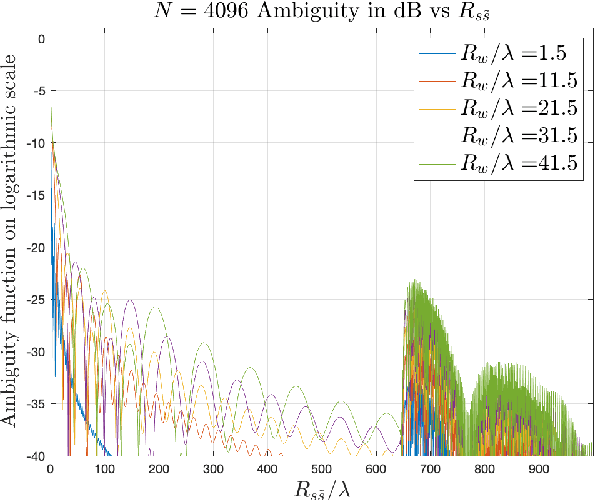
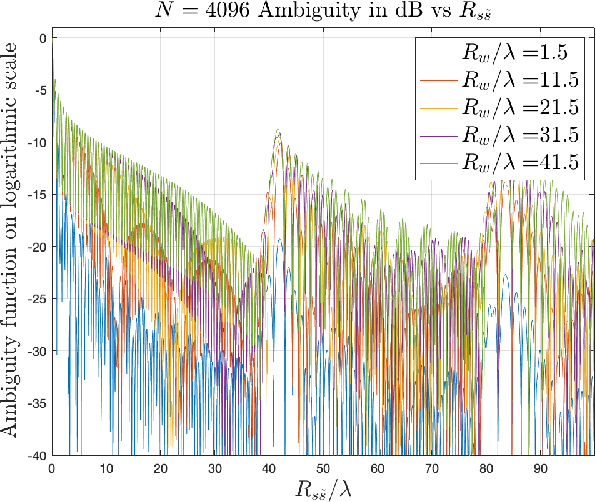
Abstract:Cell-free network is a new paradigm, originating from distributed MIMO, that has been investigated for a few recent years as an alternative to the celebrated cellular structure. Future networks not only consider classical data transmission but also positioning, along the lines of Integrated Communications and Sensing (ISAC). The goal of this paper is to investigate at the same time the ambiguity function which is an important metric for positioning and the understanding of its associated resolution and ambiguities, and the array gain when maximum ratio transmission (MRT) or MR combining (MRC) is implemented for data communications. In particular, the role and impact of using a waveform with non-zero bandwidth is investigated. The theoretical findings are illustrated by means of computational results.
Full-Duplex V2X Integrated Sensing and Communication Scenario: Stochastic geometry, Monte-Carlo, and Ray-Tracing Comparison
Jul 09, 2024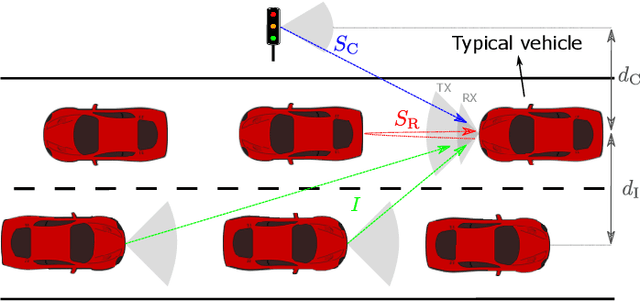
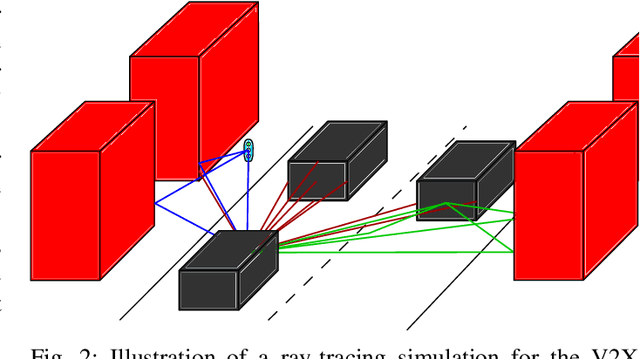
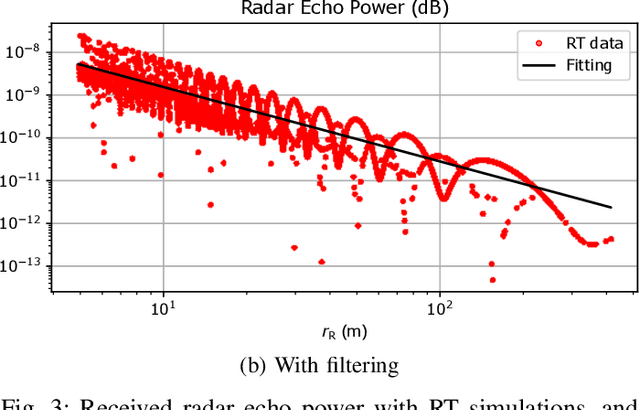
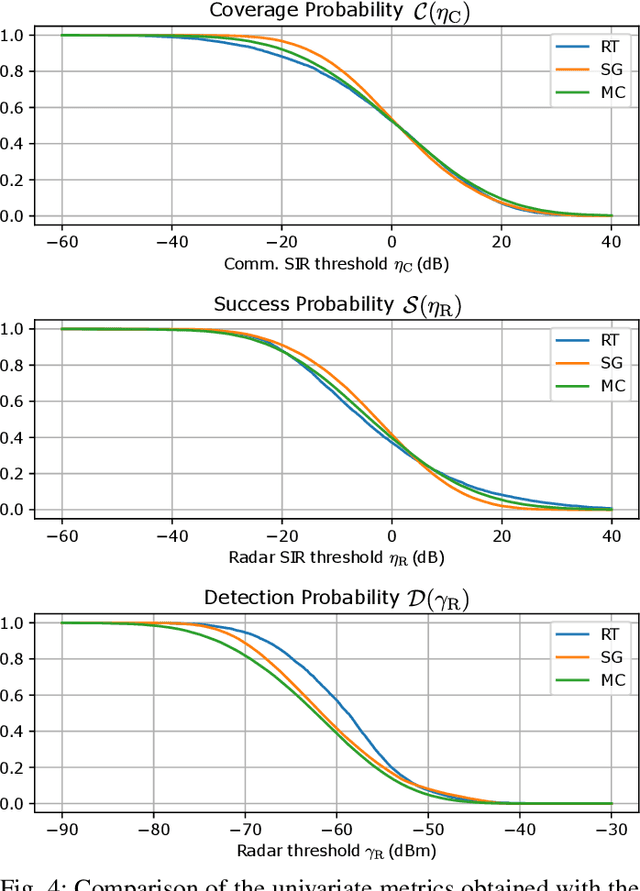
Abstract:In this paper, performance of an Integrated Sensing and Communication (ISAC) Vehicle-to-Everything (V2X) scenario is evaluated, in which a vehicle simultaneously detects the next vehicle ahead while receiving a communication signal from a RoadSide Unit (RSU) of the infrastructure. Univariate and joint radar and communication performance metrics are evaluated within three different frameworks, namely the Stochastic Geometry (SG), Monte-Carlo (MC), and Ray-Tracing (RT) frameworks. The parameters of the system model are extracted from the RT simulations, and the metrics are compared to assess the accuracy of the SG framework. It is shown that the SG and MC system models are relevant w.r.t. RT simulations for the evaluation of univariate communication and sensing metrics, but larger discrepancies are observed for the joint metrics.
Performance Bounds for Near-Field Multi-Antenna Range Estimation of Extended Targets
Apr 12, 2024



Abstract:In this paper, performance bounds for the multi-antenna near-field range estimation of extended targets are provided. First, analytic expressions of the ambiguity functions are obtained, emphasising the cooperation between the waveform delay and the near-field phase shift information. The impact of estimating the range of an extended target with a point target model is analysed, showing that a model mismatch leads to severe performance degradation in the near-field region. Secondly, Cramer-Rao bounds are derived. Expressions emphasising the parameters' impact are obtained, the parameters being the carrier frequency, and the central frequency and root-mean-square bandwidth of the waveform. The near-field range information is shown to depend on the root-mean-square value of the propagation delay derivatives, this value scaling with the fourth power of the ratio between the antenna array dimension and the target range.
Near-Field EM-Based Multistatic Radar Range Estimation
Mar 27, 2024



Abstract:Radar targets are traditionally modelled as point target reflectors, even in the near-field region. Yet, for radar systems operating at high carrier frequencies and small distances, traditional radar propagation models do not accurately model the scatterer responses. In this paper, a novel electromagnetic-based model is thus developed for the multistatic radar detection of a rectangular plate reflector in the near-field region. This model is applied to an automotive scenario, in which a linear antenna array is spread out at the front of a vehicle, and performs a radar measurement of the distance to the back of the vehicle ahead. Based on the developed received signal model, the maximum likelihood estimator of the range is designed. By exploiting the near-field target model, this estimator is shown to provide a significant gain with respect to traditional range estimators. The impact of the system and scenario parameters, i.e. the carrier frequency, bandwidth and distance to the target, is furthermore evaluated. This analysis shows that the radar resolution in the near-field regime is improved at high carrier frequencies, while saturating to the traditional bandwidth-dependent resolution in the far-field region.
Cellular Load Dependent Sleep Control for Energy Efficient HetNets with Non-Uniform User Distributions
Feb 22, 2024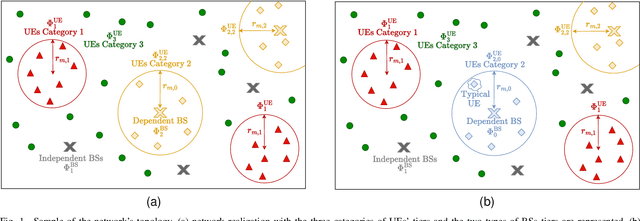



Abstract:This study proposes a novel stochastic geometry framework analyzing power control strategies in spatially correlated network topologies. Heterogeneous networks are studied, with users modeled via the superposition of homogeneous and Poisson cluster processes. First, a new expression approaching the distribution of the number of users per base station is provided. This distribution defines the load associated with each Vorono\"i cell, capturing non-uniformities in user locations and correlation to BSs positions. The power allocation is adjusted based on this load, allowing BSs to enter sleep mode when their activity falls below a defined threshold. Furthermore, the propagation model features millimeter wave transmission characteristics and directional beamforming. Considering these aspects, revisited definitions of coverage probability, spectral efficiency, and energy efficiency are proposed. Tractable expressions for these metrics are derived and validated using Monte-Carlo simulations. Asymptotic expressions are also proposed, providing further understanding on the influence of the system parameters. Our numerical results finally analyze the impact of the sleep control on the performance and display the optimal strategies in terms of energy efficiency.
 Add to Chrome
Add to Chrome Add to Firefox
Add to Firefox Add to Edge
Add to Edge